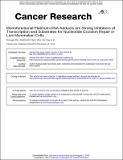| dc.contributor.author | Zhu, Guangyu | |
| dc.contributor.author | Myint, MyatNoeZin | |
| dc.contributor.author | Ang, Wee Han | |
| dc.contributor.author | Song, Lina | |
| dc.contributor.author | Lippard, Stephen J. | |
| dc.date.accessioned | 2012-08-02T18:54:21Z | |
| dc.date.available | 2012-08-02T18:54:21Z | |
| dc.date.issued | 2011-12 | |
| dc.date.submitted | 2011-11 | |
| dc.identifier.issn | 0008-5472 | |
| dc.identifier.issn | 1538-7445 | |
| dc.identifier.uri | http://hdl.handle.net/1721.1/71962 | |
| dc.description.abstract | To overcome drug resistance and reduce the side effects of cisplatin, a widely used antineoplastic agent, major efforts have been made to develop next generation platinum-based anticancer drugs. Because cisplatin–DNA adducts block RNA polymerase II unless removed by transcription-coupled excision repair, compounds that react similarly but elude repair are desirable. The monofunctional platinum agent pyriplatin displays antitumor activity in mice, a cytotoxicity profile in cell cultures distinct from that of cisplatin, and a unique in vitro transcription inhibition mechanism. In this study, we incorporated pyriplatin globally or site specifically into luciferase reporter vectors to examine its transcription inhibition profiles in live mammalian cells. Monofunctional pyriplatin reacted with plasmid DNA as efficiently as bifunctional cisplatin and inhibited transcription as strongly as cisplatin in various mammalian cells. Using repair-defective nucleotide excision repair (NER)-, mismatch repair-, and single-strand break repair–deficient cells, we show that NER is mainly responsible for removal of pyriplatin–DNA adducts. These findings reveal that the mechanism by which pyriplatin generates its antitumor activity is very similar to that of cisplatin, despite the chemically different nature of their DNA adducts, further supporting a role for monofunctional platinum anticancer agents in human cancer therapy. This information also provides support for the validity of the proposed mechanism of action of cisplatin and provides a rational basis for the design of more potent platinum anticancer drug candidates using a monofunctional DNA-damaging strategy. | en_US |
| dc.description.sponsorship | National Cancer Institute (U.S.) (Grant Number CA034992) | en_US |
| dc.language.iso | en_US | |
| dc.publisher | American Association for Cancer Research | en_US |
| dc.relation.isversionof | http://dx.doi.org/10.1158/0008-5472.CAN-11-3151 | en_US |
| dc.rights | Creative Commons Attribution-Noncommercial-Share Alike 3.0 | en_US |
| dc.rights.uri | http://creativecommons.org/licenses/by-nc-sa/3.0/ | en_US |
| dc.source | American Association for Cancer Research | en_US |
| dc.title | Monofunctional Platinum-DNA Adducts Are Strong Inhibitors of Transcription and Substrates for Nucleotide Excision Repair in Live Mammalian Cells | en_US |
| dc.type | Article | en_US |
| dc.identifier.citation | Zhu, G. et al. “Monofunctional Platinum-DNA Adducts Are Strong Inhibitors of Transcription and Substrates for Nucleotide Excision Repair in Live Mammalian Cells.” Cancer Research 72.3 (2011): 790–800. | en_US |
| dc.contributor.department | Massachusetts Institute of Technology. Department of Chemical Engineering | en_US |
| dc.contributor.department | Massachusetts Institute of Technology. Department of Chemistry | en_US |
| dc.contributor.approver | Lippard, Stephen J. | |
| dc.contributor.mitauthor | Zhu, Guangyu | |
| dc.contributor.mitauthor | Myint, MyatNoeZin | |
| dc.contributor.mitauthor | Ang, Wee Han | |
| dc.contributor.mitauthor | Song, Lina | |
| dc.contributor.mitauthor | Lippard, Stephen J. | |
| dc.relation.journal | Cancer Research | en_US |
| dc.eprint.version | Author's final manuscript | en_US |
| dc.type.uri | http://purl.org/eprint/type/JournalArticle | en_US |
| eprint.status | http://purl.org/eprint/status/PeerReviewed | en_US |
| dspace.orderedauthors | Zhu, G.; Myint, M.; Ang, W. H.; Song, L.; Lippard, S. J. | en |
| dc.identifier.orcid | https://orcid.org/0000-0002-2693-4982 | |
| mit.license | OPEN_ACCESS_POLICY | en_US |
| mit.metadata.status | Complete | |
